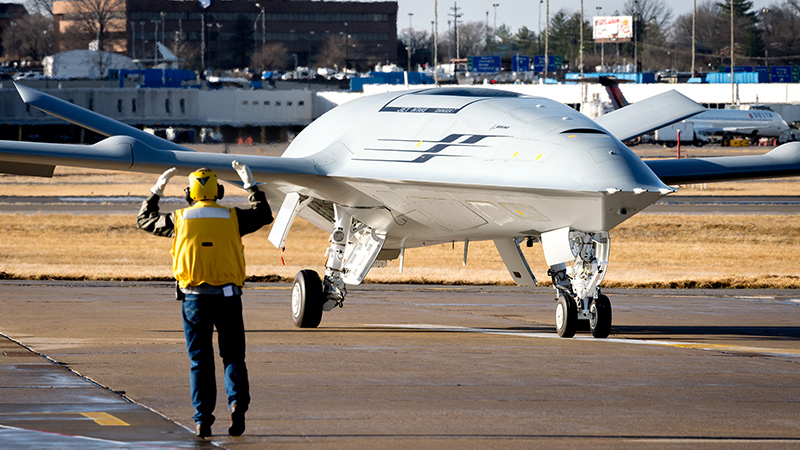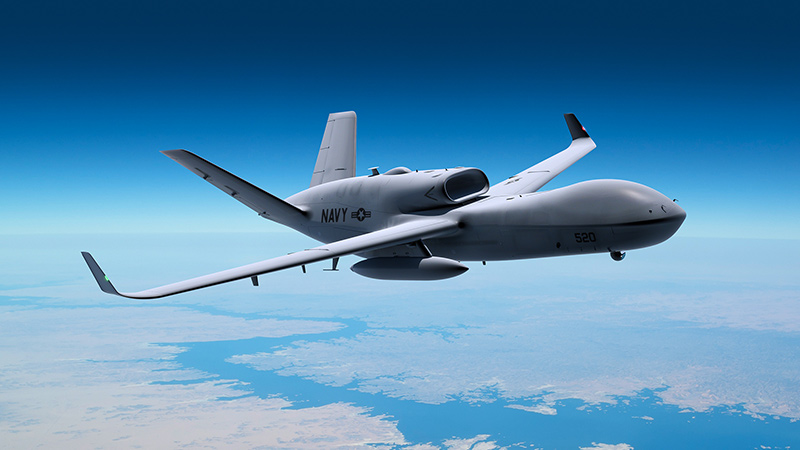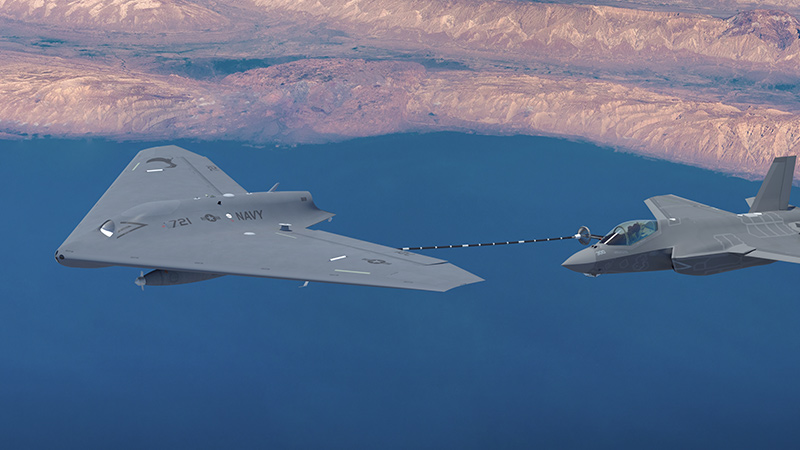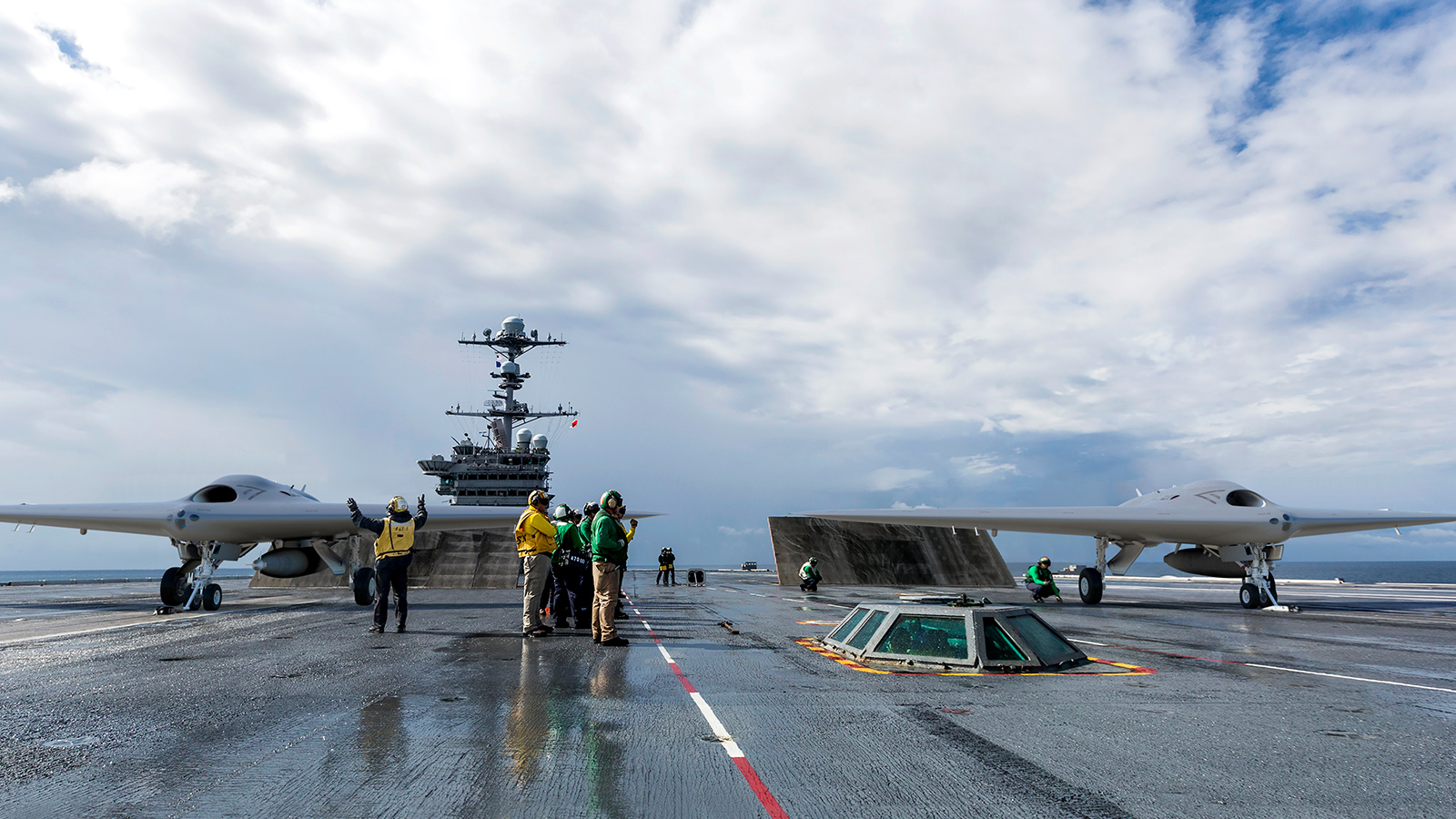Stay Up to Date
Submit your email address to receive the latest industry and Aerospace America news.
Is the U.S. Navy's proposed refueling drone the best strategy for empowering pilots to penetrate enemy airspace?
In the decade after 2005, a succession of U.S. unmanned X-planes demonstrated some of the key tasks that carrier-based U.S. Navy F/A-18s do today and that stealthy F-35C warplanes will do in the future. Test drones made arrested landings on an aircraft carrier, coordinated a simulated pre-emptive strike against enemy air defenses, and delivered bombs onto test targets in the desert.
Those who witnessed that pioneering decade of X-plane flights probably could not have predicted that in late 2015 the Defense Department would choose unarmed drones with belly pods as the first unmanned aircraft destined for its aircraft carriers. These aircraft would ferry jet fuel to conventionally piloted F/A-18s and F-35Cs to extend their ranges. It’s an unglamorous role but one that the Navy says is crucial for projecting power hundreds of kilometers from its aircraft carriers.
Late this year, the Navy plans to announce its selection of a contractor to build the drones, to be called MQ-25 Stingrays. The Navy will act as the lead systems integrator to ensure that those airframes operate correctly with software and equipment that the Navy will purchase separately for “air vehicle operators” who control the aircraft from stations aboard carriers. The primary mission will be aerial refueling plus some modest intelligence, surveillance and reconnaissance capabilities, given that the M in MQ-25 refers to multimission. At stake for the competitors is a contract that could grow into an acquisition of 72 Stingrays under a $5 billion “cost ceiling,” as the Navy calls it. The White House has requested $719 million for the program in its 2019 budget proposal, and the Navy anticipates purchasing the first four aircraft in 2023 and starting operations from carriers in 2026.
I spoke to program officials, retired military officers and a former deputy defense secretary to explore whether the MQ-25 is the best strategy for achieving the ability to reach deep into enemy air defenses from carriers. Before the MQ-25, the Navy was aiming for a stealthy surveillance and combat plane under a program called UCLASS, short for Unmanned Carrier-Launched Airborne Surveillance and Strike.
As for the contenders, Boeing’s prototype, which it calls T-1, draws on previous experimental aircraft and the design it pitched for UCLASS. General Atomics Aeronautical Systems Inc. (GA-ASI), meanwhile, is bidding a variant of its Sea Avenger carrier-jet concept that it proposed under UCLASS. In an unusual twist, the company announced in February that it has partnered with a business unit of one of its competitors, Boeing Autonomous Systems. The Boeing and GA-ASI designs have versions of V tails. Lockheed Martin, in contrast, is proposing a flying wing derived from its stealthy Sea Ghost concept that it previously pitched to the Navy.
If all goes as planned, one of these designs will be chosen to take aim at a problem shared by the Navy’s carrier-based F/A-18 Hornets, Super Hornets and EA-18G Growlers, the variants of the Super Hornet equipped for tactical jamming. Today, for some missions, pilots must take on gas in flight from U.S. Air Force tanker aircraft or other carrier-based F/A-18s configured to offload fuel from external tanks under their wings and fuselages. The time that F/A-18 pilots spend tanking diverts them from their primary strike-fighter mission while putting extra wear on the Hornet fleet.
One question on the minds of analysts and retired officers is whether a better requirement would have been to make the MQ-25 a deep-strike aircraft. The X-planes that the Air Force, DARPA and Navy worked on put a premium on radar stealth for penetrating enemy air defenses, but for the MQ-25, the Navy moved away from stealth as a requirement, given that plans call for refueling stealthy F-35Cs. Some elements of the competing designs look stealthy because of their heritage to the Navy’s previous stealth requirement.
In the view of Jerry Hendrix, a senior fellow at the Center for a New American Security think tank in Washington, D.C., the MQ-25 fails to meet naval aviation’s most glaring shortcoming: its lack of a long-range strike aircraft that can penetrate sophisticated defenses.
“The Navy’s making their brand-new, $13 billion Ford-class aircraft carriers irrelevant. If you don’t have a carrier air wing that can hit the enemy, then why do we need a carrier?” The change in requirement may have caused one of the leading contenders for the MQ-25 contract, Northrop Grumman, to drop out last October. Observers suspect that Northrop Grumman, having already designed a UCLASS contender, was not willing to spend money on a “dumbed down” design, as one person put it. CEO Wes Bush discussed the decision in an earnings call that month: “When we’re looking at one of these opportunities, let me be clear, our objective is not just to win,” he said. “Winning is great, it feels good on the day of an announcement, but if you can’t really execute on it and deliver on it to your customer and your shareholders, then you’ve done the wrong thing.” A decade ago, Northrop Grumman led construction of two X-47Bs under what was known as the Unmanned Combat Air System Demonstration program or UCAS-D. In 2013, an X-47B achieved a first when it was launched from the carrier USS George H.W. Bush and returned for an arrested landing on its deck. Another unmanned first came in 2015, when an X-47B was refueled in flight by a conventionally piloted Omega K-707 tanker plane.
Some U.S. lawmakers also have taken issue with the MQ-25’s scaled back role. Last July, the House Armed Services Committee, in a report accompanying the 2018 National Defense Authorization Act, applauded the proposed refueling capability but complained that the “documentation sent to industry did not include precision strike capability as a requirement.” Former Marine F/A-18 Hornet pilot Lt. Col. Dave Berke, who also flew F-22 Raptors with the Air Force and commanded the first operational F-35B training squadron, believes the MQ-25 should do more than tanking plus a bit of intelligence, surveillance and reconnaissance.
“You’re building a platform for a low-threat environment that can do aerial refueling and it has some electro-optical capability,” he said, using the ISR term for a camera. “But shouldn’t we build a carrier-based UAV that meets as many demands as possible and has the ability to be relevant in multiple environments? That’s a better investment.” Retired U.S. Air Force Lt. Gen. David Deptula, dean of the Mitchell Institute for Aerospace Studies, is also skeptical.
“They simply won’t be able to operate in the kind of denied airspace that significant adversaries will be able to construct,” he says.
Is there a method to the Pentagon’s madness?
Former U.S. Deputy Defense Secretary Robert O. Work told me he chose to make the Navy’s first unmanned carrier aircraft an aerial refueling drone in late 2015 after consultation with the Navy.
The buy of F-35Cs would be accelerated to give the Navy its stealth, and a fleet of tanking drones would be built to extend their range and the range of the F/A-18s, too.
“We would go with an unmanned system that we could afford,” Work says.
Organic tanking
The Navy maintains that it will be able to conduct long-range strikes against sophisticated adversaries with a combination of stealthy F-35Cs — scheduled for deployment on carriers in 2021 — and F/A-18 Super Hornets.
The key would be what the Navy calls organic tanking, the term organic referring to equipment that a service branch owns and operates instead of relying on another service branch. The Navy says the MQ-25 is a better option for organic tanking than continuing to divert some of its F/A-18s to that role or reactivating some of the now-retired S-3 Vikings, which once provided organic tanking. Right now, the Navy must either arrange Air Force tanking, which is not always possible, or sling refueling pods under the wings and fuselages of some of the F/A-18s.
Growth plans?
Another question is whether the MQ-25, with its focused missions, can serve as a springboard to more complex missions by future unmanned aircraft.
Loren Thompson, CEO of the Lexington Institute think tank, sees a crew training aspect to the MQ-25.
“There’s intrinsic danger in having people and manned aircraft operating in proximity to unmanned aircraft on deck. The Navy has to get comfortable with this. Over time, if MQ-25 works out, you can expect additional missions will gradually appear for unmanned aircraft.”
Work makes a similar point. Integrating MQ-25 into carrier operations soon, he says, means the Navy “would be able to move to an unmanned future when and if the time was right and the money was there.”
As for stealth, the Navy made clear two years ago that contractors should not try to reach for it with the MQ-25, telling Lockheed Martin, “Just to be clear, no credit will be given for the ability to evolve to a stealthy survivable design,” says John Vinson who attended the meeting in his then-role as a Skunk Works deputy.
That clarification was needed because of the work Lockheed Martin and the other MQ-25 competitors had done toward stealthy unmanned aircraft under the X-plane programs and later UCLASS.
MQ-25’s heritage can be traced to the 2003 Joint Unmanned Combat Air System program, a combined Navy and Air Force effort to field a stealthy unmanned combat air vehicle.
Contractors achieved multiple breakthroughs, including a 2005 “graduation combat demonstration” over the California desert in which two Boeing X-45As simulated a coordinated strike against radars and missile launchers.
That effort was canceled following the Pentagon’s 2006 Quadrennial Defense Review and relaunched as the Navy-only UCAS-D, the program that produced the stealthy, long-range Northrop Grumman X-47Bs. Lockheed Martin designed and built the aerodynamic edges, inlet lips and control surfaces, and arresting hooks for the X-47Bs.
Another twist was ahead. In 2011, the Navy transformed UCAS-D to the UCLASS program. Intended to produce a long-endurance drone with advanced sensors and a light strike capability, this program was also canceled, recast following a 2015 Defense Department review as the Carrier Based Aerial Refueling system — the program now referred to as MQ-25.
As for the oft-whispered conspiracy theory that an “F/A-18 mafia” is secretly determined to keep unmanned combat planes off the decks of ships, I could find no evidence for it.
Thompson says it’s not unusual for conspiracy theories to “hover nearby” when a weighty decision about an unmanned plane is made. In his view, the MQ-25 is so urgently needed that “it kind of doesn’t matter if MQ-25 happens to match up with the narrow interest of some communities.”
Avoiding overreach
Lockheed Martin’s Vinson says he “doesn’t see strong technological challenges” in designing the MQ-25. “The refueling mission does introduce issues for how we operate safely in the vicinity of manned aircraft,” he notes. “But operating as a tanker, most of the responsibility is on the pilot approaching the tanker to take fuel.”
He sees the operational link between the MQ-25 and the F-35Cs, which Lockheed Martin builds, as an advantage. “If anyone’s going to do an accelerated capability and provide an asset complementary to the F-35C, we think it needs to be us,” he says.
Vinson says Lockheed Martin focused the flying-wing MQ-25 concept it revealed in late March on the Stingray’s primary mission of aerial refueling, giving it the capability and capacity to fuel Navy fighters a long way from a carrier.
Even in the refueling role, a question about sufficiency arises. The Navy says the plane must be capable of offloading 14,000 pounds [6,350 kilograms] of jet fuel 500 miles [805 kilometers] from a carrier.
Hendrix notes that while 14,000 pounds of fuel may be enough to refuel two Super Hornets, it’s not sufficient for two F-35Cs. Vinson notes that 14,000 pounds is the program’s “threshold requirement,” and says Stingray’s “objective requirement” is higher. “We’re going for the objective fuel requirement. Our mission studies show we can refuel two F-35Cs.”
Lockheed addressed the Stingray’s secondary mission with “the ISR capability to provide an overnight watch over the carrier,” Vinson says, adding, “we also get 12 hours of endurance.”
The company’s biggest concern specific to the tanking mission is that its Stingray be able to interrupt or break off an aerial refueling evolution safely if a problem arises.
“We have to have a way to communicate clearly to the pilot taking fuel and allow him to operate his aircraft without any unsafe condition resulting from the tanker’s movements,” Vinson explains.
A broader challenge for Lockheed’s Skunk Works team is integrating its Stingray concept into the Navy’s existing aircraft carrier environment, employing all of the standard equipment used by manned aircraft — a Navy requirement for the Stingray.
As Vinson observes, the Navy is the lead integrator for MQ-25, responsible for the data links, network and control stations aboard aircraft carriers through which the Stingrays will be remotely piloted and controlled. Lockheed and its competitors are responsible for the air vehicle segment of the program.
He stresses that much of the MQ-25 requirements documentation is devoted to “interface control.” Lockheed’s design has to “be compatible with the approach the Navy’s taking to the air vehicle operator’s interface.”
Experience working with the Navy to field the F-35C has been “very helpful,” Vinson notes, giving Lockheed’s MQ-25 team access to a cadre of people with recent insight into “Navy culture.”
The MQ-25 must be compatible with the Joint Precision Approach and Landing System, which sends secure signals from three differential GPS receivers located around the deck to provide incoming pilots with a 20-centimeter (7.8-inch) box to touch down on in any weather conditions.
Vinson says that MQ-25 will utilize a version of JPALS that the F-35C is already employing. Boeing, which purchased F/A-18 manufacturer McDonnell Douglas in 1997, points to its experience with JPALS and a set of Navy-developed carrier landing software on the F/A-18s called MAGIC CARPET, short for Maritime Augmented Guidance with Integrated Controls for Carrier Approach and Recovery Precision Enabling Technologies. These efforts “reduce risk for MQ-25 JPALS integration,” Boeing says in a statement.
All told, the MQ-25 program could be well on its way, provided the Navy receives the expected funding from Congress. Deptula suggests there might still be time to address some key questions.
“When is the MQ-25 going to turn into a viable ISR strike asset that can be used in actual combat? Is it 2030, 2040, maybe 2060? If you don’t invest in overcoming hard challenges up front, you’re going to be late. Do we have the time to do that?” he asks.
Deck maneuvering
The U.S. Navy wants carrier-deck personnel to guide MQ-25s on the deck with the same gestures and signals that they give to pilots of conventional planes. Boeing, General Atomics Aeronautical Systems Inc. (GA-ASI), and Lockheed Martin each have a strategy to meet that requirement.
Boeing did not describe its approach to us, but said it has demonstrated it: “We marked the outline and key features of the carrier flight deck on the airfield (in St. Louis) and successfully conducted a series of daytime and nighttime air vehicle maneuvers demonstrating our ability to safely operate the vehicle on the [carrier] flight deck.”
GA-ASI’s program director Chuck Wright explained his company’s approach like this: “Flight deck directors make their normal gestures with special wands that interpret their motions to give the appropriate command. The command is then sent to the air vehicle, which executes it -— taxi forward or spread the wings — whatever it was.” LED lights on the MQ-25 empower it to “talk back” to the controller by changing colors to acknowledge commands, GA-ASI added. “Think Wii for aircraft control,” a reference to the Nintendo interactive video game.
Lockheed Martin did not describe its approach.
“When is the MQ-25 going to turn into a viable ISR strike asset that can be used in actual combat? Is it 2030, 2040, maybe 2060? If you don’t
invest in overcoming hard challenges up front, you’re going to be late.”
Retired U.S. Air Force Lt. Gen. David Deptula
About Jan Tegler
Jan covers a variety of subjects, including defense, for publications internationally. He’s a frequent contributor to Defense Media Network/Faircount Media Group and is the author of the book “B-47 Stratojet: Boeing’s Brilliant Bomber,” as well as a general aviation pilot.
Related Posts
Stay Up to Date
Submit your email address to receive the latest industry and Aerospace America news.







